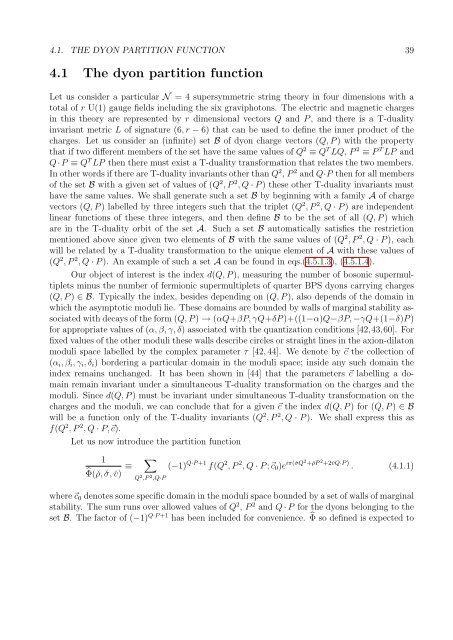PHYS08200604018 Shamik Banerjee - Homi Bhabha National ...
PHYS08200604018 Shamik Banerjee - Homi Bhabha National ...
PHYS08200604018 Shamik Banerjee - Homi Bhabha National ...
You also want an ePaper? Increase the reach of your titles
YUMPU automatically turns print PDFs into web optimized ePapers that Google loves.
4.1. THE DYON PARTITION FUNCTION 39<br />
4.1 The dyon partition function<br />
Let us consider a particular N = 4 supersymmetric string theory in four dimensions with a<br />
total of r U(1) gauge fields including the six graviphotons. The electric and magnetic charges<br />
in this theory are represented by r dimensional vectors Q and P , and there is a T-duality<br />
invariant metric L of signature (6, r − 6) that can be used to define the inner product of the<br />
charges. Let us consider an (infinite) set B of dyon charge vectors (Q, P ) with the property<br />
that if two different members of the set have the same values of Q 2 ≡ Q T LQ, P 2 ≡ P T LP and<br />
Q·P ≡ Q T LP then there must exist a T-duality transformation that relates the two members.<br />
In other words if there are T-duality invariants other than Q 2 , P 2 and Q·P then for all members<br />
of the set B with a given set of values of (Q 2 , P 2 , Q · P ) these other T-duality invariants must<br />
have the same values. We shall generate such a set B by beginning with a family A of charge<br />
vectors (Q, P ) labelled by three integers such that the triplet (Q 2 , P 2 , Q · P ) are independent<br />
linear functions of these three integers, and then define B to be the set of all (Q, P ) which<br />
are in the T-duality orbit of the set A. Such a set B automatically satisfies the restriction<br />
mentioned above since given two elements of B with the same values of (Q 2 , P 2 , Q · P ), each<br />
will be related by a T-duality transformation to the unique element of A with these values of<br />
(Q 2 , P 2 , Q · P ). An example of such a set A can be found in eqs.(4.5.1.3), (4.5.1.4).<br />
Our object of interest is the index d(Q, P ), measuring the number of bosonic supermultiplets<br />
minus the number of fermionic supermultiplets of quarter BPS dyons carrying charges<br />
(Q, P ) ∈ B. Typically the index, besides depending on (Q, P ), also depends of the domain in<br />
which the asymptotic moduli lie. These domains are bounded by walls of marginal stability associated<br />
with decays of the form (Q, P ) → (αQ+βP, γQ+δP )+((1−α)Q−βP, −γQ+(1−δ)P )<br />
for appropriate values of (α, β, γ, δ) associated with the quantization conditions [42,43,60]. For<br />
fixed values of the other moduli these walls describe circles or straight lines in the axion-dilaton<br />
moduli space labelled by the complex parameter τ [42, 44]. We denote by ⃗c the collection of<br />
(α i , β i , γ i , δ i ) bordering a particular domain in the moduli space; inside any such domain the<br />
index remains unchanged. It has been shown in [44] that the parameters ⃗c labelling a domain<br />
remain invariant under a simultaneous T-duality transformation on the charges and the<br />
moduli. Since d(Q, P ) must be invariant under simultaneous T-duality transformation on the<br />
charges and the moduli, we can conclude that for a given ⃗c the index d(Q, P ) for (Q, P ) ∈ B<br />
will be a function only of the T-duality invariants (Q 2 , P 2 , Q · P ). We shall express this as<br />
f(Q 2 , P 2 , Q · P,⃗c).<br />
Let us now introduce the partition function<br />
1<br />
̂Φ(ˇρ, ˇσ, ˇv) ≡<br />
∑<br />
Q 2 ,P 2 ,Q·P<br />
(−1) Q·P +1 f(Q 2 , P 2 , Q · P ;⃗c 0 )e iπ(ˇσQ2 +ˇρP 2 +2ˇvQ·P ) . (4.1.1)<br />
where ⃗c 0 denotes some specific domain in the moduli space bounded by a set of walls of marginal<br />
stability. The sum runs over allowed values of Q 2 , P 2 and Q · P for the dyons belonging to the<br />
set B. The factor of (−1) Q·P +1 has been included for convenience. ̂Φ so defined is expected to

















